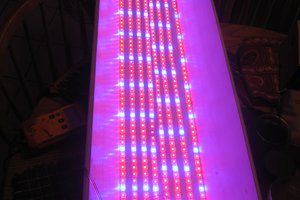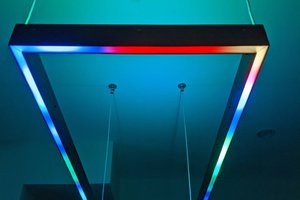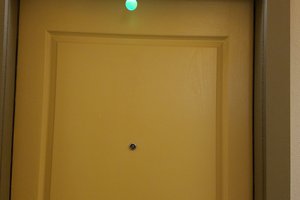For me, I needed to start at a very basic standpoint. Others, I'm sure, will be moving at a faster pace.
For the basic approach of affixing fiber to LEDs, please check out Frank Mim's excellent article at:
https://makezine.com/projects/how-to-connect-optical-fibers-to-leds-and-sensors/
I [mostly] used his suggested Parts:
Plastic optical fiber, 2.2mm [I wanted glass (an aesthetic choice as much as a moral one) and used about 17 feet, 7 fibers at 2' each, 3 at 1' each]
LEDs, 5mm epoxy encapsulated
Plastic cement or cyanoacrylate (CA) glue, aka super glue [I used Starbond EM-150 Medium, and loved it. Can't imagine trying to do this with a 'tube' from a hardware store]
I also added a few runs of copper wire to order to better support the stalk (where I used a heavier gauge) and to highlight the 'pistil' (where I slipped a tightly wound lighter gauge wire over the end of the fiber). I considered this an acceptable variant, as copper and fiber are both used in telecommunications.
Resistors: (2) 680 Ohm resistors, (4) 560 Ohm resistors
I also took a few variants to his Tools:
Hobby Knife or clippers / diagonal cutters (to cut and strip the fiber)
Sandpaper: 200 grit, 400 grit, and 600 grit (for finishing fiber tips)
Drill or Dremel
3/64" bit [I used a 1/16" to no apparent ill effect]
Vise or clamp
DC Power Supply (adjustable)
Soldering iron / station
Sketching this out, I determined I wanted 10 fibers:
(4) 2' runs for the Blue 'petals'
(6) runs for the green stalk: (3) 1' runs and (3) 2' runs
(1) 2' run for the Orange 'pistil'
Another variant from Frank's approach I attempted was to drill two holes into each LED in hopes of doubling efficiency -- for example, if I could use only 2 Blue LEDs to power the (4) 2' runs, instead of using 4 Blue LEDs I could shave over 6 Volts of power. (See example here)
In reality, this cost me a few LEDs where I messed up the drilling, and it also didn't necessarily result in 100% efficiency gain [I'm estimating gain closer to 80%], as I needed both perfect drilling combined with the perfect seating of the fiber within the LED bulb. Often, one fiber strand was brighter than the other sharing the same bulb. Either way, I will continue to pursue and optimize this approach, as this afforded me a ~16V solution, saving 12V:
(2) Blue LEDs at ~3.2V of Forward Voltage per (according to packaging -- though there does appear to be a fair degree of variation in regards to LEDs)
(3) Green LEDs at ~2.4V /
(1) Orange LED at ~2.0V /
I followed Ben Finio's advice and designed a parallel circuit @ 20 mA per LED, using 680 Ohm resistors across the Blue LEDs and 560 Ohm resistors for the Green and Orange LEDs.
Building out, the next steps were to attach the fiber to the LEDs and run into the breadboard. Before that, however, if you want to get crazy: working towards the LED, lightly running 400 grit sandpaper on the outside of a fiber strand will expose light. Nicking the fiber with something like a razor will cause 'spots of color' to appear.
Feeding from the bottom through the fake rock, I then started gluing together any "loops" I wanted to build into the piece (including "petals"), using clothespins to hold together while it set.
[One note here is to be aware of your choice of fiber and the principles of your choice (including bend radius, side/end-emitting properties, etc.) I started with an end-emitting, but am interested to try side-emitting in the next iteration. For the curious: "Intro to Fiber"]
Once the glue on each LED was finished drying completely, I ran pairs of loose wire from the breadboard to the LEDs, soldering...
Read more » Rich Morrissey
Rich Morrissey
 AVR
AVR
 Made2Hack
Made2Hack
 Steve Pomeroy
Steve Pomeroy
 Grayson Schlichting
Grayson Schlichting